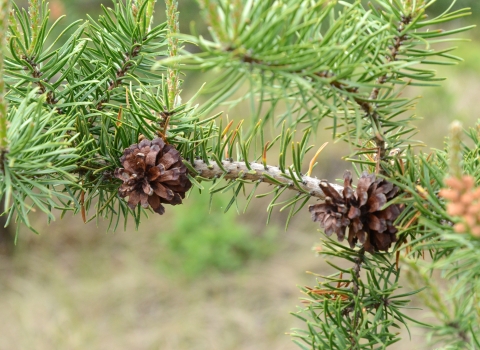By Lauren “Ren” Sarantopulos, the Newest Biological Science Technician for the Western Washington Fish & Wildlife Conservation Office
--------------------------
One of the most frequent questions I am asked by friends and family alike is, “What led you to pursue a career in fish biology?” The short answer is, I didn’t really choose fish, fish chose me. As someone with a deep love for rivers and all things water related, I am a self-proclaimed, “obligate fish nerd.”
I can always trace the start of my affinity for water back to Wyoming. Raised in the country, I often found myself with ample time to wander the 10-acre farm my family called home. Enormous cottonwood trees and rolling green hills spanned my backyard, but to me the most thrilling part was the little river that meandered its way through the heart of the property. As soon as I would arrive home from school, I would beeline straight down the hill to the water’s edge, roll up my pant legs, and wade in. I would spend hours meandering its banks – exploring, swimming, and collecting water bugs – or “macroinvertebrates” as I now know them. I even once fashioned my own makeshift raft out of a couple of inflatable sleds and paddled the entire length of our property.
My parents eventually sold the farm and moved us from Wyoming to Arizona in search of warmer weather. It was there I attended Northern Arizona University in Flagstaff to study environmental science. I knew I liked wildlife and being outside, but I lacked a direction on what I wanted to focus on. Like many of my classmates, I decided I was going to study large charismatic megafauna, like wolves or bears. It wasn’t until my sophomore year, when I met the university’s aquatic ecology professor, that I was steered back into the realm of water. After chatting about our shared affinity for macroinvertebrates, she offered me a position working in her lab where I later completed two years of undergraduate research on amphipods.
I often tell people I worked my way “up the food chain,” when it came to aquatic science. The summer before my last year at university I was offered an internship through the Student Conservation Association, focusing on cutthroat trout conservation in Yellowstone National Park. I spent three months on the fisheries crew, hiking, backpacking, and rafting my way through some of the West’s most pristine wilderness. I not only saw hundreds of blue-ribbon worthy trout, but also countless bison, bears, wolves, and other spectacular wildlife. I remember calling my parents from the park and telling them I had found my dream job. I was undoubtedly hooked.
After graduation, I knew I wanted to stay in the world of aquatic science. I started down the seasonal science technician path with an internship through the ESA-USGS Cooperative Summer Fellowship Program. They matched me with the U.S. Geological Society office at the Grand Canyon Monitoring and Research Center (GCMRC) based in Flagstaff, where I aided in research on the aquatic food base of the Colorado River. It was here I received my very first taste of whitewater rafting during one of their science-led river trips, which unsurprisingly, I quickly fell in love with.
Big rivers and the lure of whitewater continued to be something I couldn’t get enough of. After my internship with USGS ended, I volunteered with any research group at GCMRC that would take me on, itching to get back down to the river. I eventually landed a technician job with the Arizona Game and Fish Department conducting Grand Canyon fisheries monitoring on threatened species like the humpback chub (Gila cypha). I spent the next year living the fisheries technician dream – rafting the canyon by day and netting electroshocked fish through rapids by night.
Despite my love for the Grand Canyon, I always promised myself I would return to Yellowstone National Park for another season. In the summer of 2023, I followed my heart back to Wyoming to work as a crew lead for the National Park Service, this time donned in the full ranger uniform. I have experienced many amazing summers in my life, but those six months working with Yellowstone cutthroat trout had me remembering what set the hook so deep into fisheries science for me years before.
Through loving rivers, I have grown to also love the fish that live in them. I am excited to begin my next chapter in fisheries science as a biological technician with the Western Washington Fish and Wildlife Conservation Office. I feel very lucky not only for the opportunity to continue my work with salmonids, but also with species and landscapes that are brand new to me.
Already in my few months with the office I have had the opportunity to assist with several projects, many of which have been ongoing for years. In addition to aiding on kokanee spawning nest surveys, I have helped track Chinook and coho salmon while rafting the Elwha River, as well as aided in collecting data on hatchery steelhead. My primary focus though, has been on the ongoing fish ecology projects in the Lake Washington basin, focusing on juvenile salmon predation studies. I cannot wait to continue to discover what else I have in store at the Western Washington office, because I know that despite seldom knowing what is around the next bend, I will never be led astray if I keep following the water.










